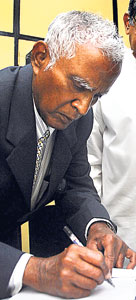Gamini Punchihewa's 450 page publication captioned "Souvenirs of a Forgotten Heritage" is an epic bibliography. It focuses on a wide cross-section of related subjects including anthropology, social and cultural changes, agricultural development during the post-war "green revolution", urbanization and its impact on the rural people, in our country.
Mr. Punchihewa was directly associated with the pioneering multi-purpose post-independence agricultural project in our country i.e. the Gal Oya Development Scheme, the brain-child of the 'Father of the Nation' Prime Minister D.S. Senanayake. He had the distinction of being a State officer involved in transforming a rural feudalistic agricultural community to a large-scale, state sponsored, agricultural expansion and colonization scheme, which involved alienation of a vast extent of jungle to productive, irrigated, agricultural lands to meet the needs of an increasing population…
 |
| The author autographing a book |
The social impacts of this transformation necessitated a good understanding of cultural priorities and social values of the resident folk, because it required inducing them to change their farming practices of chena cultivations and nomadic lifestyles to the concept of multi-purpose agricultural projects using irrigation waters and other updated techniques. Mr. Punchihewa's inimitable charm and his ability to liaise with the village folk with divergent ideologies, held him in good stead to effect this transformation. The chapters on In the Nilgala Frontier, Land of the Nagayas, Our Veddahs and the Tribal World of other Aborigine Gypsy Farmers of Gal Oya Valley and Gypsy Farmers of Gal Oya, describe his personal experiences and illustrate how Mr. Punchihewa effected this transformation with minimal social and cultural upheaval.
This book is not merely a narration of the sequalae of activities that transferred the pristine jungles to an agricultural oasis but also reflects the social and cultural changes that accompanied this transformation. Since it delves into events and beliefs that prevailed during that time (i.e. about half a century ago) its documentations are of historical significance and a recording of the prevalent folk-lore also. The basis of the Sinhala social foundation of that era was the concept of "the tank and the temple.. the village and the fields".
The author sees these concepts and values being changed to the consumptive and competitive society of the present day. His nostalgic reflections reiterates that such values are only "…souvenirs of the past.. " and are being fast forgotten.
Archaeological sites in the form of Buddha statues, dagabas and moonstones in the Gal Oya valley are also identified and referred to. These help to establish the existence of a well developed civilization in these areas and the relationship that prevailed between the better known archaeological sites renovated in the North Central Province. The ruins of Buddha statues that existed in the precincts of the Digavapi dagaba and other shrines in the proximity of Maligakanda confirm such a close relationship. Rock caves and Brahmin inscriptions dating back to the 3rd century BC have been identified here along with Veddah drawings of men, women and animals.
Closer to Ampara and Mahaoya, the author describes the ruins of the Pulukuna Chaitya and at Buddama he refers to the ruins of a rock temple with a Buddha statue and a Pattini devale at Nevugala, indicating the influence of Hinduism in this region. The author has taken great pains to describe all the inscriptions, drawings and the ruins to establish the existence of a flourishing civilization in this region.
In order to correlate associated historical events, Mr. Punchihewa refers to the questionable arrogance of the British rulers during their occupation, the Uva Rebellion and Major Rogers' elephant hunts. He reflects on the effect of these incidents on the local population. The more recent Smithsonian survey, of wild elephants conducted by Dr. McKay in the 1950s, is also made reference to.
Wild elephants and related anecdotes and folk tales have been highlighted in providing explanations and justifications for the beliefs and reactions of the village folk, of that era. These add a lighter vein to the historical references in the text. The rituals that are adhered to when dealing with elephants find explanations in these interesting revelations.
All these, though related but divergent aspects of the Gal Oya valley, as described by the author, leaves one to wonder what the author's priority emphasis was when compiling this book, but nevertheless it leaves the reader very much wiser to most of the socio-cultural changes that accompany such large scale colonization projects. It also provides retrospective explanations to some unprecedented socio-cultural incidents that occur, as a result of such mass migrations of unrelated individuals.
The book has provided Mr. Punchihewa the opportunity to reflect on one of his main concerns – i.e., the wild elephants of Ceylon. He has devoted significant numbers of chapters to the wild elephants of the Galo Oya valley. He laments the uninhibited encroachments into elephant territory which is pushing these majestic animals away from their abodes. First it was the colonial rulers who displaced them from their traditional abodes in the hills to commence coffee and tea plantations and now it is the uninhibited agricultural expansions that are driving them away from their natural abode. to so called "Protected Areas" which don't appear to provide them the protection they require.
The many illustrations and photographs by George Schokman, Byrd Gunasekera, Nihal Fernando, L.C. Samararatne, Hamilton Gnanamuththu and Dr. Spittel himself add value to this book .
I would consider "Souvenirs of a Forgotten Heritage" an informative, historical, educational and anthropological epilogue of the people, the animals and the flora of the Gal Oya valley; such a concise and comprehensive coverage of all these aspects is yet to be published. It would therefore make excellent reading to any persons with an interest in any one of these aspects of the valley because it is an accurate historical record of the progressive changes that occurred in the region, during and after the implementation of the Gal Oya Development Project. |

